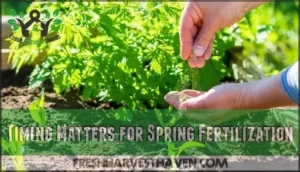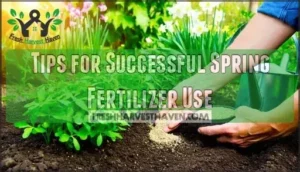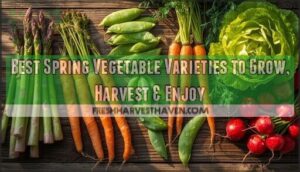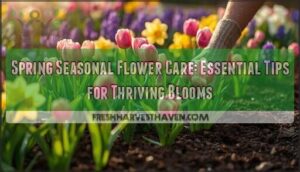This site is supported by our readers. We may earn a commission, at no cost to you, if you purchase through links.
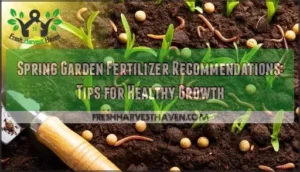
Skip the guesswork: most commercial growers swear by soil tests, and for good reason. A well-chosen spring garden fertilizer does more than wake sleepy seeds; it fine-tunes the balance that turns patchy beds into lush borders and steady harvests.
If you’re ready to see stronger seedlings and fuller blooms, it’s time to dig a little deeper into what your spring garden soil really wants.
Table Of Contents
- Key Takeaways
- Preparing for Spring Fertilization
- Best Spring Garden Fertilizer Recommendations
- Timing Matters for Spring Fertilization
- Selecting The Right Fertilizer Application Method
- Tips for Successful Spring Fertilizer Use
- Frequently Asked Questions (FAQs)
- What is the best fertilizer for spring?
- When to fertilize garden plants?
- How should I fertilize my Garden this spring?
- How do I choose the right fertilizer for my spring gardening needs?
- When should fertilizer be applied?
- What is the best fertilizer for a vegetable garden?
- What is the best fertilizer for spring gardens?
- When should I apply 10-10-10 fertilizer to my vegetable garden?
- What number fertilizer should I use in the spring?
- Is 13-13-13 fertilizer good for gardens?
- Conclusion
Key Takeaways
- Testing your soil before spring planting reveals nutrient gaps and helps you choose the right fertilizer, so you don’t waste money or harm your plants.
- Matching your fertilizer to both soil type and crop needs—using the NPK ratio on the bag—promotes strong growth and keeps nutrients in balance all season.
- Fertilizing at the right time, especially before planting or just as new growth appears, sets your plants up for their best start and healthy blooms.
- Applying fertilizer the right way—watering after, loosening mulch, and using methods like banding or side-dressing—ensures roots get what they need while avoiding overfeeding.
Preparing for Spring Fertilization
Before you spread fertilizer across your garden beds, you need to understand what’s already in your soil. Testing your soil and choosing the right fertilizer will set you up for a season of healthy growth. Here’s what you should focus on before spring planting begins.
Soil Testing for Optimal Fertilizer Use
Soil testing is your first step to fertilizer success. Over 90% of commercial growers rely on soil analysis to guide their fertilizer decisions, and you should too. Testing reveals nutrient deficiencies and pH levels before you waste money on the wrong products. Here’s how to get started:
- Collect 10 to 20 soil cores from your garden area
- Choose between DIY kits or professional lab analysis using Mehlich III extraction
- Review results for nitrogen, phosphorus, and potassium levels
- Check pH impact analysis, since soil pH below 6.0 limits phosphorus availability
Soil testing for nutrients offers real economic benefits. Studies show that soil test-directed fertilization can reduce phosphorus use by up to 30% while improving nitrogen efficiency by 8–15%. You’ll also support variable-rate application strategies if you manage multiple garden zones. Even with adequate phosphorus levels, crops may still benefit from added P fertilizer. Testing method comparison shows that professional labs provide the most reliable nutrient deficiency detection, helping you choose fertilizers that match your soil’s actual needs rather than guessing.
Understanding Your Soil Type and PH
Once you know your nutrient levels from soil testing, the next step is understanding how soil texture and pH influence what’s available to your plants. Soil texture determines how well water and nutrients move through your garden. Sandy soils drain at rates exceeding 30 mm per hour, which means nutrients can leach away before roots absorb them. Clay soils hold moisture well—up to 400 mm per meter—but drainage suffers. Loam offers the ideal balance, balancing drainage with nutrient retention for healthier crops. Understanding the different soil types is essential for effective crop management.
Now, let’s talk about pH influence on nutrient availability:
- Most crops thrive between pH 6.0 and 7.5, where nutrient uptake peaks
- Acidic soils below pH 5.5 restrict phosphorus absorption and increase toxic metal solubility
- Alkaline soils above pH 7.5 reduce iron and zinc availability
Testing importance can’t be overstated for crop selection. Adjusting soil pH to around 6.5 can boost nutrient availability by 30%, directly impacting plant vigor and yield.
Choosing The Right Fertilizer for Spring
Now that you know your soil’s type and pH, it’s time to fuel your garden for spring success. Start by reading fertilizer labels—those three numbers show NPK ratios that tell you exactly what nutrients you’re getting.
A balanced fertilizer like 10-10-10 or 12-12-12 works well for general spring needs, but choosing the right fertilizer means matching plant needs to what you’re growing. Heavy feeders like tomatoes need more phosphorus, so look for something like 5-10-10.
Organic options such as compost or fish emulsion build soil health over time while feeding plants gradually. Synthetic benefits include quick nutrient delivery when plants need an immediate boost. Your spring fertilizer choice affects both immediate growth and long-term soil vitality, so consider types of fertilizers that balance your garden’s current requirements with future health.
Best Spring Garden Fertilizer Recommendations
If you want your spring garden to flourish, choosing the right fertilizer starts with knowing your plants’ needs and understanding the NPK ratios on the bag. Whether you lean toward organic options like compost or prefer slow-release blends for steady nourishment, the best fertilizer for spring balances nutrient supply with convenience.
Keen gardeners often weigh organic vs synthetic fertilizers, considering both effectiveness and long-term soil health. For quick results, liquid solutions such as 16-4-8 are a favorite—especially in fertilizing vegetable gardens. With rising costs, cost analysis also matters.
Here are top picks for spring garden fertilizer:
- All-purpose 10-10-10 blends
- Espoma Organic Lawn Booster
- Scotts Green Max Lawn Food
- Compost and bone meal mixes
Timing Matters for Spring Fertilization
When you want the best results from your spring garden, getting the fertilizer timing right makes all the difference. Each type of plant has its own rhythm for when it needs a boost.
Here’s what you should keep in mind as you plan your next steps.
Fertilizing Before Planting New Crops
Imagine giving your garden a head start—fertilizing before you plant is like fueling up before a road trip. To set the groundwork for strong crops, focus on soil nutrient levels and essential plant nutrients.
Here’s a practical spring garden fertilizer plan:
- Mix a starter fertilizer, like 10-20-10, into the top few inches—think timing: two weeks before planting.
- Work in organic amendments first for healthy structure.
- Water thoroughly after applying for even nutrient uptake.
Fertilizing Established Plants in Spring
Once spring sunshine starts coaxing green shoots from the soil, it’s the perfect time to treat your established plants to the nutrients they’ve been waiting for. Spring garden fertilization means focusing on established plant needs—think balanced blends like a 12-12-12 spring fertilizer for trees, phosphorus-rich options for blooms, and slow-release options for fruiting varieties.
Incorporate organic amendments, water consistently after fertilizing, and always monitor plant health. Fertilizing established plants in spring keeps them vigorous and ready for a thriving season.
Avoiding Over-Fertilization in Spring
How can you keep fertilizer burn and salt buildup at bay this season? Overdoing spring feeding may bring more root damage, yellow leaf tips, and even unwanted water pollution from nutrient runoff. The trick is to match your garden’s real needs—a soil test pinpoints this for you. Besides, slow-release or organic choices nurture the soil microbiome and support steady, healthy growth.
- Watch for fertilizer burn: brown edges, stubborn wilting, or stunted roots signal trouble brewing.
Selecting The Right Fertilizer Application Method
The way you apply fertilizer can make a real difference in how your garden thrives. Depending on your space, your soil, and what you’re planting, certain methods work better than others.
Let’s walk through some practical options for getting nutrients to your plants this spring.
Broadcast Fertilization for Large Areas
If you’ve got a big patch of ground to cover, broadcast fertilization is the gardener’s shortcut to getting nutrients exactly where your plants need them—without wearing out your boots. It works a bit like dusting flour over dough: the goal is even coverage. Rotary spreaders quickly cover large spaces, while drop spreaders deliver precise lines—either way, equipment calibration is a must.
Walk steadily in overlapping passes to avoid fertilizer waste and keep soil compaction in check. You’ll want to dodge breezy days; fertilizer drifting off target never did anyone’s garden any favors. With the right method, you cut labor costs and boost results.
Here’s a quick comparison:
| Spreader Type | Benefit |
|---|---|
| Drop Spreader | Precise application |
| Rotary Spreader | Fast, wide coverage |
| Even Coverage | Reduces patchiness |
| Calibration | Prevents overuse |
| Labor Costs | Saves time |
Band Fertilization for Rows and Beds
Ever wonder how to give your crops a little extra boost without wasting a sprinkle of fertilizer? Band fertilization is your answer, targeting nutrients with precision right along your row placement or bed layouts. Instead of spreading fertilizer everywhere, you place thin bands of granular spring garden fertilizer just 2–3 inches from seeds or seedlings. This method keeps key nutrients close for easy uptake—think of it as setting the table, but only for the guests you know are coming.
- Place fertilizer at the right depth for strong root contact.
- Keep bands near seedlings for maximum nutrient access without risk of burning.
- Focus on efficient fertilizer application methods, so your vegetable gardens get what they need, right when they need it.
It’s savvy, simple, and saves resources.
Side-Dressing for Targeted Nutrition
Hungry plants can be a lot like teenagers—they always come back for seconds, and that’s where side-dressing steps in to satisfy their midseason cravings. With this fertilizer application method, you tuck a band of nutrients a safe distance from the stem, right at the plant’s drip line.
Careful application techniques—factoring in your soil type, sidedressing fertilizer choice, and proper proximity—mean garden roots get exactly what they need, when they need it most. Nutrient timing matters, especially with crops that bolt or set fruit. Water after fertilizing for best results.
| NPK Ratio | Plant Proximity | Timing |
|---|---|---|
| 10-10-10 | 3" from stem | Early growth |
| 20-10-10 | 6" from stem | Midseason |
| 5-10-10 | 3" from stem | Pre-bloom |
| Compost | Mix in soil | Pre-planting |
Tips for Successful Spring Fertilizer Use
When you use fertilizer in spring, a few extra steps can make all the difference for your plants. The right approach helps your garden thrive and keeps things in balance.
Here are some simple tips to help you get it right from the start.
Watering Consistently After Fertilization
Just like you wouldn’t leave a teabag to dry out before pouring hot water, your garden needs a steady drink after fertilizing to help all those nutrients soak in where they matter most. Watering after fertilization is essential for nutrient absorption, solubilizing minerals, and proper root hydration. Aim for even, gentle moisture—enough to prevent burn but not wash away your effort. Consistent moisture unlocks the real magic of your fertilizer application.
After fertilizing, give your garden a gentle, thorough watering so nutrients reach roots right where they matter most
- Imagine plump, healthy roots drinking up every drop!
Avoiding Liquid Fertilizers on New Seedlings
When your tiny seedlings are just settling in, they’ll thank you for skipping liquid fertilizers and choosing a kinder, slower approach. Seedling burn and root damage are real risks with liquid fertilizer—those fragile roots simply can’t tolerate sudden nutrient surges.
That’s why granular or slow-release options are your best friends. These alternative methods gently feed seedlings, preventing nutrient imbalance and growth inhibition while respecting sensitive roots every step of the way.
Raking Mulch for Effective Fertilizer Application
Think of mulch as the cozy blanket your soil loves, but before sprinkling on spring fertilizer, it pays to give that blanket a gentle shake with a rake. Moving mulch aside—just enough to let fertilizer reach the soil—boosts Fertilizer Penetration and Soil Aeration, helping roots soak up nutrients right away. Choose Mulch Types that encourage nutrient distribution, and don’t forget: regular mulch raking keeps everything breathing smoothly. After applying spring garden fertilizer, smooth the mulch back for steady moisture and weed control.
- Loosen mulch before fertilizer application
- Vary raking frequency based on mulch type
- Target even nutrient distribution
- Reapply mulch for a tidy finish
Frequently Asked Questions (FAQs)
What is the best fertilizer for spring?
If you want your garden to thrive come spring, start with a balanced fertilizer—think Jobe’s Organics All Purpose (4-4-4).
An organic option with a solid NPK ratio, it feeds slowly, improving soil health for lush growth.
When to fertilize garden plants?
Timing spring fertilization is key—wait until soil temperature rises and plant growth kicks in. Fertilizer application timing matters most in early spring, during active bloom cycles, and when weather patterns are mild. Morning or evening schedules boost absorption.
How should I fertilize my Garden this spring?
Isn’t it funny how your plants crave both attention and restraint?
To fertilize your garden this spring, match plant-specific needs, watch for nutrient deficiency signs, choose between organic vs synthetic, mind fertilizer burn prevention, and respect environmental considerations.
How do I choose the right fertilizer for my spring gardening needs?
Choosing the right fertilizer starts with understanding fertilizer labels—look for NPK ratios that match your plant needs and soil type.
Explore organic options and various fertilizer forms. Tailor your selection for spring, especially when fertilizing vegetable gardens.
When should fertilizer be applied?
As the old saying goes, “Strike while the iron is hot.” Fertilizer application timing hinges on soil temperature and plant growth.
For best results, sync your spring fertilizer application schedule with warming soil and active root development.
What is the best fertilizer for a vegetable garden?
A balanced fertilizer with an NPK ratio like 10-10-10 works well for most vegetable gardens. If you prefer organic options, compost and manure boost soil health, while matching plant needs. Application methods matter—don’t overdo it!
What is the best fertilizer for spring gardens?
Much like a canvas needs the right paint, your spring garden flourishes with a fertilizer boasting a balanced NPK ratio.
Choose between organic options for soil health or quick-acting synthetics—always tailor to your plant-specific needs.
When should I apply 10-10-10 fertilizer to my vegetable garden?
Apply 10-10-10 fertilizer just before planting vegetables, or as soon as you see strong new growth.
Work it into the soil, follow the application rate, and water deeply—best uptake depends on soil temperature and plant needs.
What number fertilizer should I use in the spring?
A spring garden thrives with a balanced fertilizer, often labeled 10-10-10 or 12-12- This NPK ratio covers most plant needs, supporting healthy growth.
Adjust blends if you know your soil or certain crops require more nutrients.
Is 13-13-13 fertilizer good for gardens?
Think of 13-13-13 fertilizer as a well-balanced breakfast for your garden—matching common NPK ratios like 12-12-12 or 10-10-
While it fits most plant needs, always match application rates to soil health and specific crops.
Conclusion
Think of your spring garden as a living symphony, each plant craving its perfect note. By following spring garden fertilizer recommendations, you’re not just feeding roots—you’re composing harmony beneath the surface.
Soil tests, well-timed watering, and exact nutrients invite everything to flourish in time. Trust this attention to detail; it’s the unseen conductor guiding those vivid blooms and thriving crops.
With intention and care, you nurture not just a garden, but the promise held in every growing season.
- https://extension.colostate.edu/topic-areas/yard-garden/fertilizing-the-vegetable-garden-7-611/
- https://agrilifeextension.tamu.edu/library/gardening/fertilizing/
- https://soiltesting.cahnr.uconn.edu/suggested-fertilizer-practices-for-vegetables-and-herbs/
- https://www.gardeningknowhow.com/garden-how-to/soil-fertilizers/fertilizer-rates-and-applications.htm
- https://www.epicgardening.com/fertilize-vegetable-garden-spring/

